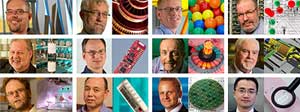Siemens increases patents granted to nearly 58,000

Inventor of the year 2010
All in all, it’s another demonstration of the innovative power of the more than 30,000 R&D employees who work at Siemens. The total number of patents granted increased from 56,000 in 2009 to 57,900.
At an awards ceremony in Munich on November 22, Siemens CEO Peter Löscher honored 12 particularly successful research and development employees as “Inventor of the Year.” These 12 alone account for around 1,300 granted individual patents. Since 1995, Siemens has been presenting its annual Inventor of the Year award to outstanding researchers and developers whose inventions make a major contribution to the success of the company
SIM card for smart grids
The distribution and use of electricity is undergoing fundamental change, as IT is being used to make power grids smarter. The aim of this modernization is to use the smart systems to compensate autonomously for the fluctuating levels of energy generated from renewable sources, like wind and solar power, in order to ensure that more of the renewable energy is included in the power grid. An important part of the Smart Grid in the future could be electric vehicles, because their batteries could also provide intermediate storage for the power. To make sure the interests of vehicle users and energy suppliers don’t conflict, Dr. Rainer Falk, 40, developed a method for virtually partitioning an accumulator, thus making it possible to separately manage the stored energy for the e-vehicles and for the energy companies. Falk, who works for Siemens Corporate Technology in Munich, also developed a type of SIM card for private energy customers that enables them to change their energy providers very easily. The chip contains all the data needed to access the server of the energy provider as well as cryptographic keys for encrypting the data transferred between the servers and the customer’s module. Falk has 172 invention applications to his name, and 26 granted individual patents in 107 IPR families
LED modules in the shower
Light-emitting diodes (LEDs) are rapidly replacing conventional incandescent bulbs and lamps in automobile headlights, traffic signals, and room and building lighting systems. This wave of success has been made possible in part by Charles Coushaine, 50, who has played a major role in optimizing the design of LED modules, which include a semiconductor crystal, reflector trough, shroud, and socket for use in a broad spectrum of applications. Although the interactions among the electrical, thermal and optical characteristics of LEDs are challenging, Coushaine calls what he does product design. This refers not so much to the aesthetic aspects of LEDs as to the combination of their components and assembly. For nearly 20 years now he is working on improving LED products for cars. His first major success was the development of Joule, the world’s first standardized LED system for the automobile industry. Since 2006 he develops new potential applications for LEDs. Whether it’s a dining room table mat with LED lighting, folding LED pocket flashlights, or the “Dot-it” LED — the self-adhesive round lamps you turn on and off with a quick press of the surface — all of these ideas came from Coushaine. In the U.S., a lamp that he designed specifically for use in the shower is also a big success. Coushaine developed an LED lamp that produces its own electricity from a tiny generator powered simply by the flow of water to the shower head. With 184 granted individual patents he is one of the most creative Siemens inventors
Turbines with heat shield
To improve systems such as gas turbine power plants, engineers have to do a lot of tweaking — or take an entirely new approach. Take Francis Jurjen Ladru (40), for example, who since his university studies has been working on how materials can withstand the greatest possible temperatures and thereby enhance the efficiency of power plants. With gas turbines, higher operating temperatures mean greater efficiency with a simultaneous reduction of CO2 emissions. The rising temperatures subject the turbine blades to increasingly severe loads. To prevent the tremendous heat of up to 1,400 C from overly stressing the material and causing the blades to deform or crack, a two-layer coating developed by Siemens is applied to the blades. For this coating Ladru has developed a new method that not only shortens the coating process but also uses less material and makes the ceramic layer more stable. He has 60 invention applications, 16 granted individual patents, and 36 IPR families to his name.
Media Contact
More Information:
http://www.siemens.com/innovationnewsAll latest news from the category: Business and Finance
This area provides up-to-date and interesting developments from the world of business, economics and finance.
A wealth of information is available on topics ranging from stock markets, consumer climate, labor market policies, bond markets, foreign trade and interest rate trends to stock exchange news and economic forecasts.
Newest articles
Humans vs Machines—Who’s Better at Recognizing Speech?
Are humans or machines better at recognizing speech? A new study shows that in noisy conditions, current automatic speech recognition (ASR) systems achieve remarkable accuracy and sometimes even surpass human…

Not Lost in Translation: AI Increases Sign Language Recognition Accuracy
Additional data can help differentiate subtle gestures, hand positions, facial expressions The Complexity of Sign Languages Sign languages have been developed by nations around the world to fit the local…

Breaking the Ice: Glacier Melting Alters Arctic Fjord Ecosystems
The regions of the Arctic are particularly vulnerable to climate change. However, there is a lack of comprehensive scientific information about the environmental changes there. Researchers from the Helmholtz Center…



